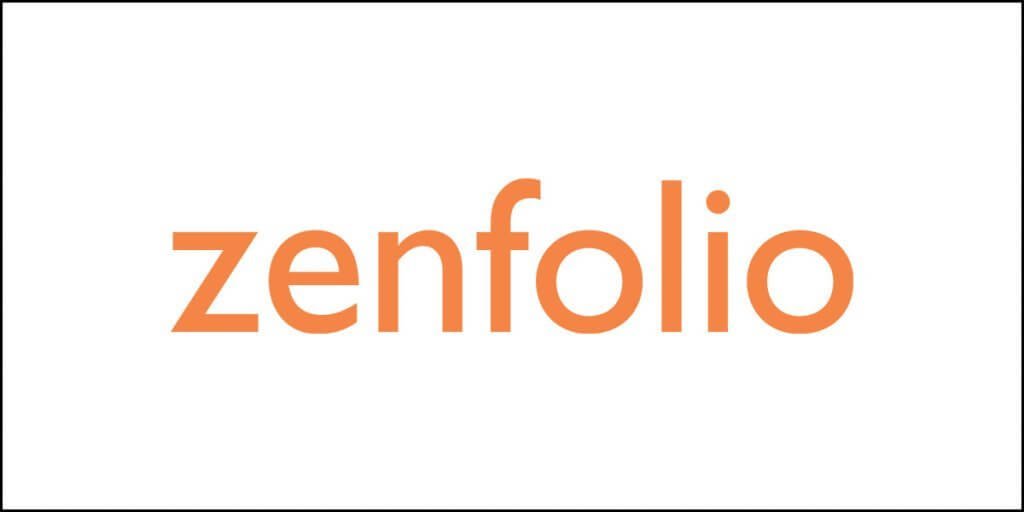What is the Yoast SEO Plugin?
With 5+ million downloads on the WordPress plugins repository, Yoast SEO plugin is one of the most famous WordPress plugins that help bloggers and website owners to perform on-page SEO.
From assisting with the creation of post specific meta description and SEO title to performing sitewide SEO, Yoast SEO plugin makes it really easy to perform on-page SEO. Additionally, the plugin also creates XML sitemaps, does content analysis, and allows room for Social Media Optimization.
It is an all-in-one plugin created with rookies in mind, but even experienced SEO experts can use it to improve page ranking.
Yoast SEO plugin comes in two flavors – free and premium. The free version is powerful enough for all basic SEO needs. The premium version comes with some extra features like the ability to add additional keywords or key phrases, perform local SEO, WooCommerce SEO, Video and News SEO, automatic interlinking suggestion, etc.
The inability to add multiple keywords or key phrases using the free version is perhaps the greatest drawback of the free Yoast SEO plugin. It that bothers you, you can look for alternatives like All-in-One SEO and RankMath.
Yoast SEO plugin is the de facto SEO tool for millions of users across the world, irrespective of how many WordPress websites each user makes. It is a powerful and yet simple plugin that helps with on-page SEO.
Honestly, it is incorrect to use the term on-page SEO. There are different aspects of on-page SEO, and content is one of them. Since Yoast helps to perform SEO only for the content, I think it is better to say that Yoast is for in-content SEO, or simply content SEO.
On-page SEO also involves optimization of page-level HTML codes, CSS codes, etc. The immense popularity of Yoast SEO plugin doesn’t make it the final word in the world of content SEO.
Other major players offer much more than what the free version of Yoast has to offer, and that too completely free! You do need to keep in mind that irrespective of which SEO plugin you are using, the ambit of SEO is far bigger than what a simple plugin offers.
Do not forget the simple rule – your blog or website is for your readers. You will understand your readers better than a plugin can. So, use an SEO plugin as technical support, and not as an alternative to your wits and your wisdom.
The two should go hand-in-hand because while your wisdom and understanding can take you only so far as the content quality is concerned. You will need an SEO plugin for the technical side.
The technical side involves creating meta description for home page, blog posts, and pages, inserting focus keywords, creating XLM sitemaps, creating structured data (schema markup), etc. The SEO plugin of your choice should be able to do all that for you.
Yoast SEO Plugin – Pros and Cons
What is a WordPress plugin? It is a piece of code that adds additional functions to your core WordPress site. So, you can look at a plugin as a software. Just like every other software in the market, even Yoast has its set of strengths and weaknesses. No plugin can be perfect!
Remember that when it comes to coding, no one can achieve perfection. There will always be something or someone better.
So, over years of hands-on experience with Yoast, I found out what’s good about Yoast and where it goes wrong.
Do remember that what I am saying here is my personal opinion, and it can differ from what others think. Since I don’t write generic reviews, and since I write only about things that I use, I will make no exception for Yoast either. I will tell you what I feel and what I think Yoast should improve.
Sounds good? Great! So, here we go…
The Strengths of Yoast
Simple Interface: It is simple to use. The interface has gone through several upgrades over the years to offer a streamlined experience. The newest interface that integrates with the Gutenberg editor is my most preferred interface so far.
Easy Sitemap: Creating sitemaps with Yoast is easy. You don’t have to do anything. Yoast will do everything for you.
SEO Data Import: Yoast can import SEO data from other SEO plugins, which is great.
SEO Checklist: It works as an SEO checklist. The plugin will tell you whether you have already used a keyword somewhere else or not. It will tell you about the keyword density.
Yoast will also tell you whether you have used the keyword too many times in the images or not. These are technical things, and Yoast does a great job in helping you to fix the issues.
Content Analysis: Yoast will do content analysis and give your article a readability score. In other words, it will tell you how difficult it is to understand your content.
It will also tell you what percentage of your content uses the passive voice. It will even tell you when you use the same word to start three consecutive sentences. That’s good if you want to improve your English writing skills.
Protects from Content Scrapers
There are many websites out there that are content scrapers. What they do is that they will go through the RSS feed of various websites, take content from there, and republish them.
This hurt! Google often fails to identify who published the content first. Google will then rank the scraper site higher than the source site from where the content is scraped.
Yoast will prevent that from happening by adding a link to your blog piece in the RSS feed.
But…
All that glitters is not gold! Some of its strengths are its weaknesses. Let me walk you through them again.
The Weakness of Yoast
The SEO Checklist Issue: It is a 14-point checklist, and trust me, it can quickly become overwhelming for rookies. Seeing orange or red colors popping up in that checklist can be stressful. Often, trying to fix one can tamper with the other.
The Content Analyzer Cannot Understand Intent: If you are writing a very technical blog post or something scientific in nature, the readability score will take a hit.
Sometimes, starting three consecutive sentences using the same keyword makes more sense, and the reception of such sentences is not awkward at all. Furthermore, using such sentences is sometimes comforting from a reader’s perspective.
So, the content analyzer of Yoast is far from being perfect. It works with a set of rules that it fails to bend or break as and when requires. Because of the inflexibility of the content analyzer, you can see those small red or orange lights pop up, creating a stressful scenario.
To top all that, the content analyzer is not even a full-fledged grammar-correction tool! That’s the reason why I turn it off! Yes, you can turn off the content analyzer completely. I use Grammarly Premium to improve my writing skills.
Yes, Grammarly Premium isn’t perfect either. Even it fails to understand the intent at certain times. Still, you can tweak its settings to change the way it analyzes content. It is needless to say that it does a stellar job of fixing grammar.
Green Isn’t Always Good: In the pursuit of all green dots, you may just end up doing things wrong. For instance, Yoast will want you to include the focus keyword in the alt attributes of the images. Doing that incorrectly will make the red light pop.
Yoast will ask you to add both external and internal links. Doing so doesn’t necessarily help with on-page SEO. You don’t always need to add links, and links don’t always do wonders.
It turns out that certain Yoast rules are against SEO best practices. It can actually harm your blog rather than helping you if you overly depend on Yoast rules.
I am saying this from personal experience. I have a standing site that ranks well for many keywords. Yoast shows me red and orange lights for many of them, and yet they rank in the top three! How does that happen?
Also, there are articles on the blog that achieved all green on Yoast. They don’t rank at all! Why?
If getting all green was the ultimate SEO trick, most of my blog posts should have ranked in Google search.
So, the Yoast SEO plugin is plagued with various weaknesses, and you should never completely depend on it.
Yoast SEO Plugin – Ease of Use
Now, the moment of truth! How easy is Yoast? If you are a newbie, can you handle it? This is where I will give you a step-by-step guide to setup Yoast SEO and use.
Just to be clear, I will be using screenshots from my existing website. So, you will see prepopulated data. All my sites are production sites, and some of them are using other SEO plugins. Since I don’t want to make a switch, I will stick with a site that already has Yoast.
I will still try to make the overall guide as detailed as possible to help you.
Also, I use the free version of Yoast. So, this user guide will be based on the free version.
Let’s begin.
Installing and Activating Yoast SEO
I will start with the assumption that you already have a new site with no SEO plugin installed. Yoast will be the first plugin that you will install.
To do that, head over to your WordPress site dashboard and from the Plugins menu, click on the Add New submenu item. This will open up the plugins repository of WordPress.
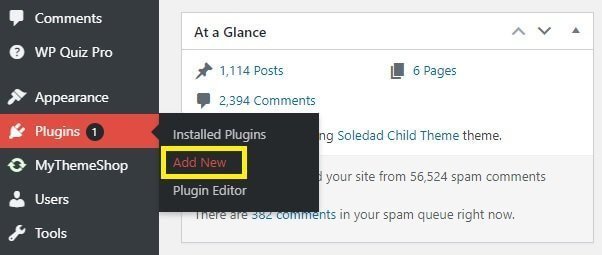
In the repository, search for “Yoast.” The first option that you will see is the Yoast SEO plugin. To ensure that you are selecting the right one, check the number of installations. It should show 5+ million.
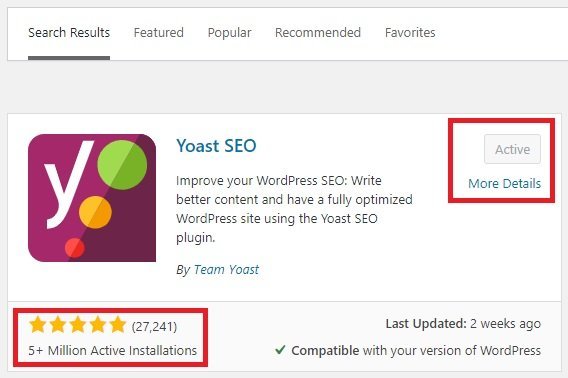
In the image above, you will see that it is showing “Active.” That’s because I have already installed Yoast SEO and activated it.
Since you are about to install the plugin, you will see the Install button instead of the Active button. Click on that button to install it, and once it is installed, you will see the button called “Activate” in the place of the Install button. Click on the Activate button to activate the plugin.
Once you activate the Yoast plugin, you will see a welcome screen of sorts. I don’t remember what you will see. I guess it will take you through the setup process. You can just cancel it out if you want or carry out the onscreen instructions. I usually don’t follow the setup screen. It is up to you.
Even if you are not seeing any welcome screen or setup screen, it is fine. Don’t panic. Yoast is installed. To verify that Yoast is installed, look at the dashboard menu. You should see the option called SEO.
This is what I mean:
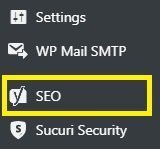
If you see this option, it means that your site now has the Yoast SEO plugin installed. All you need to do now is to configure Yoast. This brings us to the next segment – Yoast Configuration.
Continue reading…
Yoast SEO Plugin Configuration
General Settings Segment
To configure Yoast, hover your mouse on the SEO menu item on the left of your dashboard and click on the General option. This is what I mean:
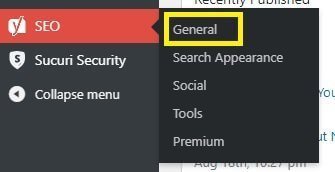
Once you click on the General option, you will see the General settings page of Yoast. You will see this:
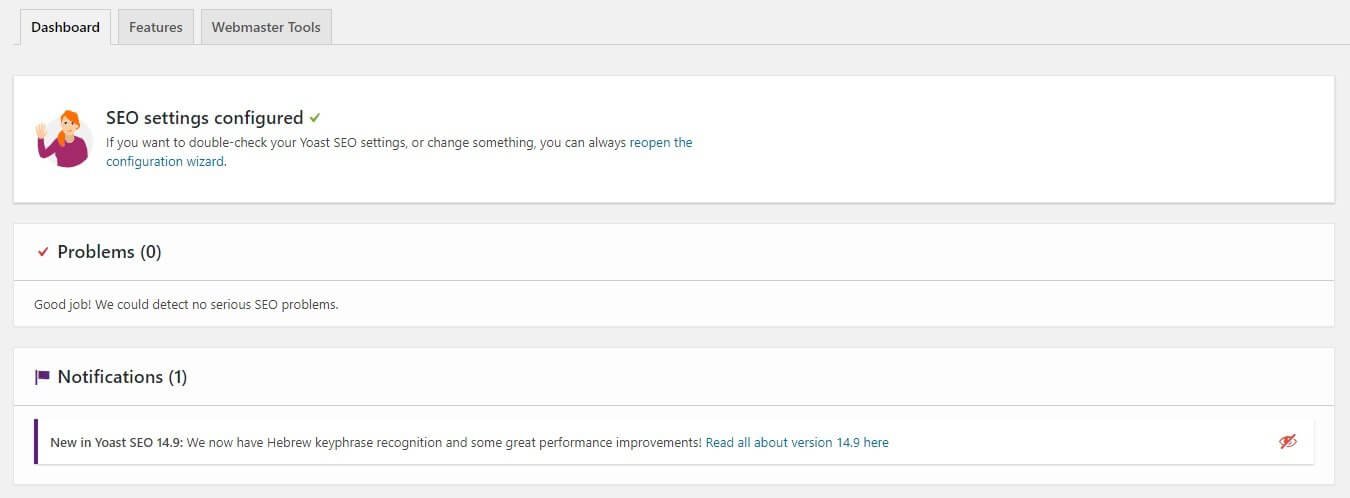
You will see three tabs on the top. They are ‘Dashboard,’ ‘Features,’ and ‘Webmaster Tools.’
The Dashboard Tab
The dashboard tab will allow you to open the configuration wizard. It will also tell you the list of problems with your website. And you will see a notification segment. If there is some new feature from Yoast, the notification segment will show that.
The Features Tab
Heading over to the Features tab, you will see some general settings option. You can turn them off or turn them on. There is a quick explanation available for each option. So, if you are confused and you don’t know whether to keep an option active or not, you can click on the small question mark icon you will see next to each option. It will open up hidden text with an explanation.
This is what you will find in the Features tab:
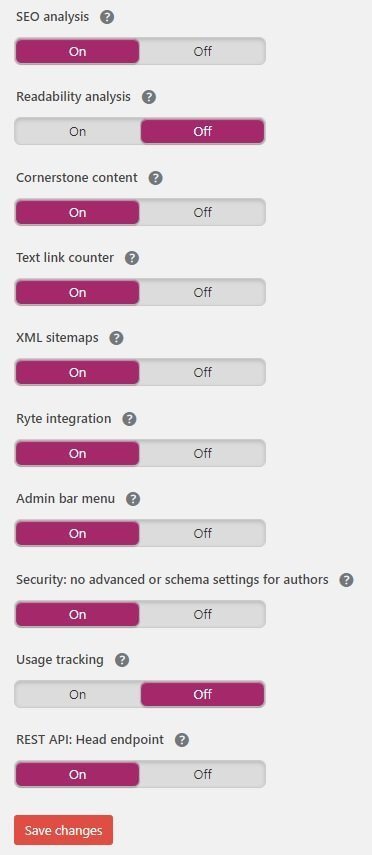
The image above shows you the settings that I use. Keep SEO analysis on! That’s essential. It will give you the 14-point checklist that I talked about earlier. I will show examples later.
I always turn off the Readability Analysis. I told you earlier that I always use Grammarly premium to fix my writing issues. Be it passive voice usage or grammatical errors, or using repetitive sentences, Grammarly gives me insights. In addition to that, Grammarly also has a solid plagiarism checker option, which allows me to ensure that whatever I write is not plagiarized.
If you are wondering what a cornerstone content means, it simply indicates the most detailed articles on your blog. Yes, your cornerstone articles can be 10K to 15K words long, or even longer. The word count doesn’t really matter. The idea here is to ensure that you are creating robust and information-rich content.
Cornerstone articles play a vital role. There will be keywords for which you cannot rank so easily. To rank for those keywords, you need to write the most detailed articles you can think of. Just how detailed? There is no right answer to that.
Go through your competitors and find out what they are writing. Then, create an article that is way better than the articles your competitors have (if you don’t know how to do that, you can read my guide on Ubersuggest). Google prefers such cornerstone articles that add true value, are very detailed, and answers the questions that people usually ask.
The more detailed your article is, the better are your chances to rank for that keyword.
Also, do not forget that you may be writing articles on similar topics. Google needs to way to understand which one of those similar articles is the most important. Marking an article as a Cornerstone article tell Google what it wants to know.
When you write multiple similar articles, you can link them internally to the cornerstone content. This internal linking will tell Google which article is the most important one. If many smaller articles on your site are linking to one detailed article on your site, Google will know that the detailed article is the most important one, and start ranking it.
So, if your blog is from a niche where you have the scope of writing cornerstone articles, you should turn on this option. There are certain niches where there cannot be a cornerstone article. For instance, if you are working with listicles (top 10 lists or something like that) like the famous LISTVERSE website, you don’t need to activate the cornerstone module. It is of no use in such websites.
What about the Text Link Counter module? You need to leave it on! This module refers to internal linking. Your site needs internal links. Have you seen Wikipedia? You will see that Wikipedia has numerous internal links.
You don’t need to have as many interlinks as Wikipedia has. However, it is essential that you interlink the best performing posts and cornerstone articles. Interlinks or internal links allow the pages of your site to share link juice with each other. This helps the not-so-popular articles in getting traffic from popular ones on your site.
Here is how the internal links count shows up on the post list:

Note the green highlighted numbers. They represent how many articles on my site are linked from these posts. The red highlighted numbers tell how many articles on my site are linking back to these two posts. The green numbers are called outgoing internal links, while the red numbers are called incoming internal links.
The more these numbers, the better. However, you should not try to create internal links forcefully. Do it only when an opportunity shows up.
What about XML sitemaps? Keep it on! You will need XML sitemaps because Google needs them to index your site. To find the XML sitemap for your website, click on the question mark icon next to XML Sitemaps and click on the link which says ‘See the XML Sitemap.’ This is how it looks like:

Keep Ryte integration on. It tells search engines like Google and Bing whether your site is indexable or not. You may or may not turn on the Admin bar menu. It doesn’t really matter. Though I keep it one, I never use it.
Coming to the Security module, I will suggest that you keep it on if you have a multi-author blog with each author having permission to post and do SEO. Turning this option off will give those authors the power to remove posts from Google search, change canonical URL, or use advanced robots to do damage to your site.
Do not turn off the security, even if you are the only author on your blog. This will ensure that you don’t accidentally cause any damage.
The last two options are really not important. You can leave them on or turn them off. Once you are done, hit the save button!
The Webmaster Tools Tab
This is the last tab in the General segment of the Yoast SEO plugin. This is where you input the verification codes from search engines like Google, Baidu (do keep in mind that Baidu is Chinese), Bing, and Yandex (Russian). I don’t care about Baidu, Bing, or Yandex. So, I always use only Google.
Here is what it looks like:
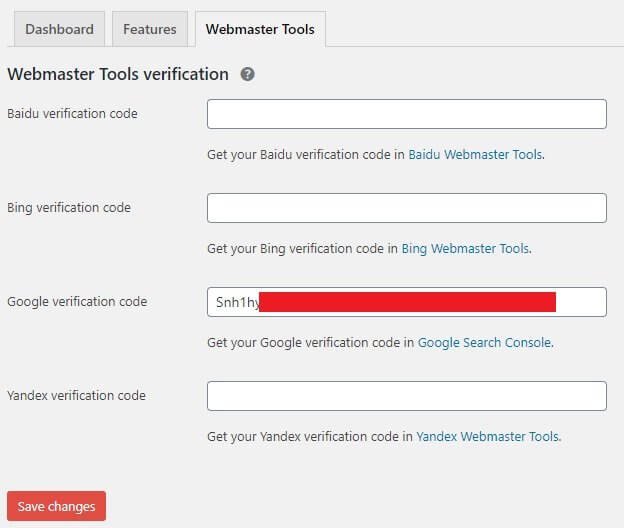
You need to input these values or at least Google’s verification code to ensure that you get accurate SEO data and insights from Google Search console. It is not necessary that you have to enter the data here. You can use various other verification methods, including HTML file upload, changing TXT values in DNS settings, etc.
Of course, this is by far the easiest method!
Search Appearance Setting Segment
The next segment is the Search Appearance. What you do here will determine how your site appears in search results of various search engines. You can get to this segment by hovering your mouse on the SEO menu item on the left of your dashboard and clicking on the Search Appearance option.
This is what I mean:
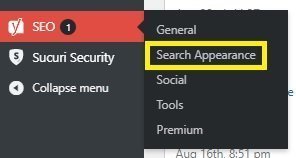
Once you click on Search Appearance, you will land on the Search Appearance segment. This is what you will see:
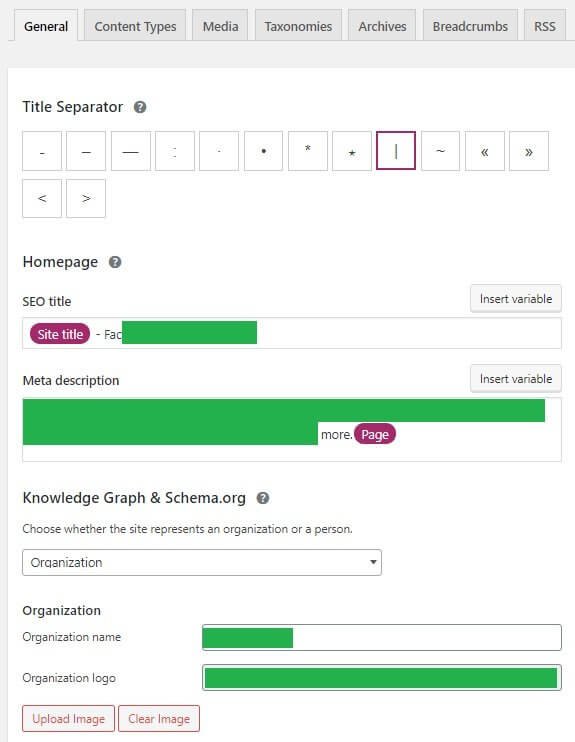
You will find multiple tabs here. The default tab selected is the General tab. Let me walk you through each tab separately.
The General Tab
The first thing you encounter in the General tab is the Title Separator segment. This is just a styling feature that appears between the post title or page title and site title.
Take a look at this:
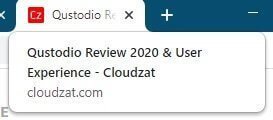
Notice that hovering the mouse on the browser tab shows the name of the post, which is ‘Qustodio Review 2020 & User Experience.’ You can then see a hyphen and then the website name, which is ‘Cloudzat.’
Here the hyphen is the title separator. Before the separator is the post title, and after the separator is the site title or the website name. You can change this separator. Here it is a hyphen. You can use any other option that you want. You have all these options to select from:

Under the title separator option is the option for Homepage SEO title and the Meta Description for the Homepage.

The SEO title segment will get prepopulated because Yoast will pick you the site name as site title and the site description as the description. You usually add these options while installing the WordPress site on the webserver. You need not fiddle around with this.
In the Meta description field, add a well thought out description that includes the primary keywords of your niche. Be descriptive enough to capture the core idea of the website.
The next segment is the Knowledge Graph and Schema Segment. What you set here will show in your site’s metadata. The data you input here is the data that Google uses for its Knowledge Graph Engine, which powers the Knowledge Graph Card or simply, the Panel.
You encounter the Knowledge Graph Card almost every day whenever you conduct a Google search. You see something on the right-hand side. It is the card or the panel.
Take a look at this:
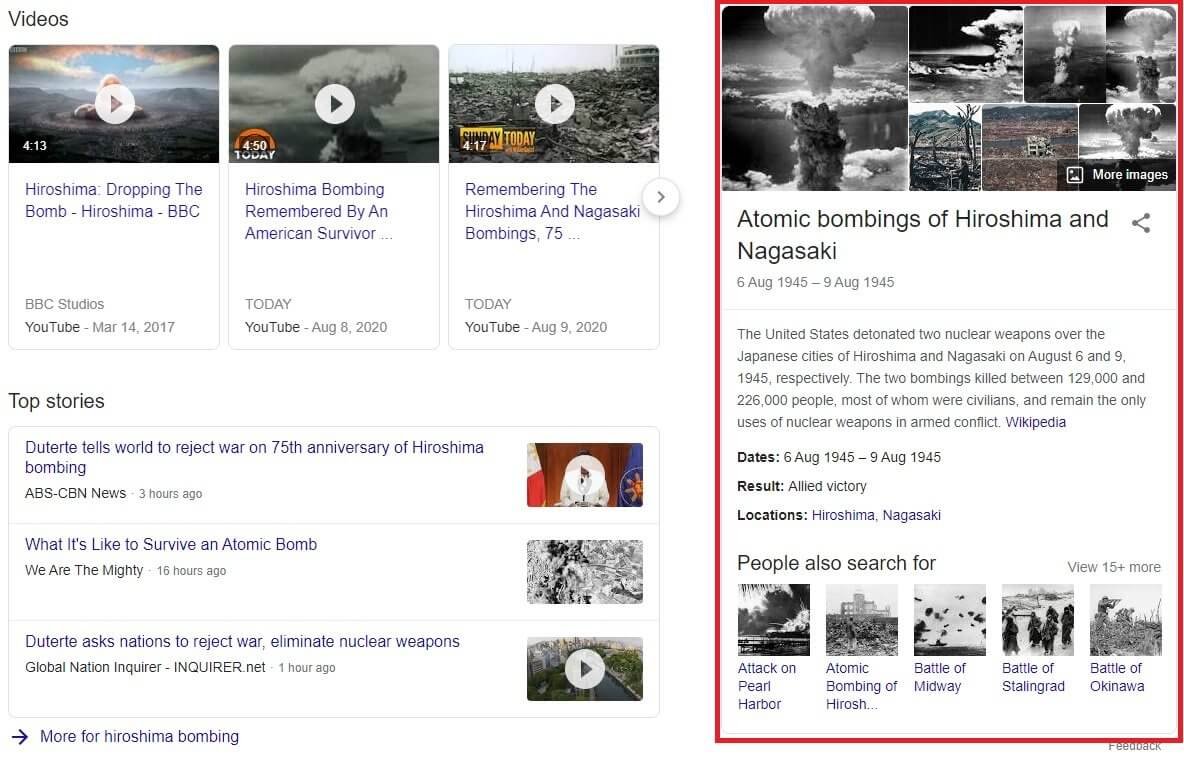
The segment highlighted in red is the Knowledge Graph Card or the Panel. Getting in the panel means that your content is authority content.
To create this card, Google needs Knowledge Graph data. Yoast allows you to enter the data with ease. If your content is truly amazing, if it is the best content on the web, you will get on that card.
To set the Knowledge Graph and Schema data, you need to tell Yoast whether you are an organization or an individual.
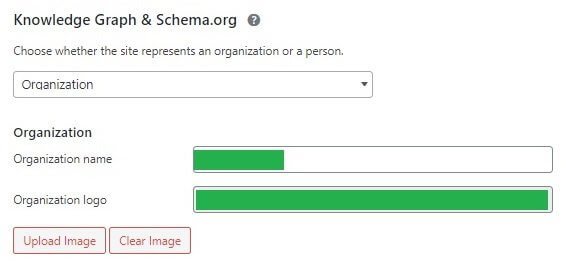
If you select ‘Organization,’ Yoast will pull the organization name and logo (if you have already uploaded a logo). If you haven’t uploaded a logo, you can use the ‘Upload Image’ button to upload the logo.
If you select ‘Person,’ Yoast will ask you to upload your image or avatar, and it will ask you to select a user. Add the data and hit the save button.
The Content Types Tab
Next is the Content Types tabs, where you have to set options for posts and pages. If you have other content types like quizzes, you can set options for that as well.
The first segment here is for blog posts. This is what it looks like:
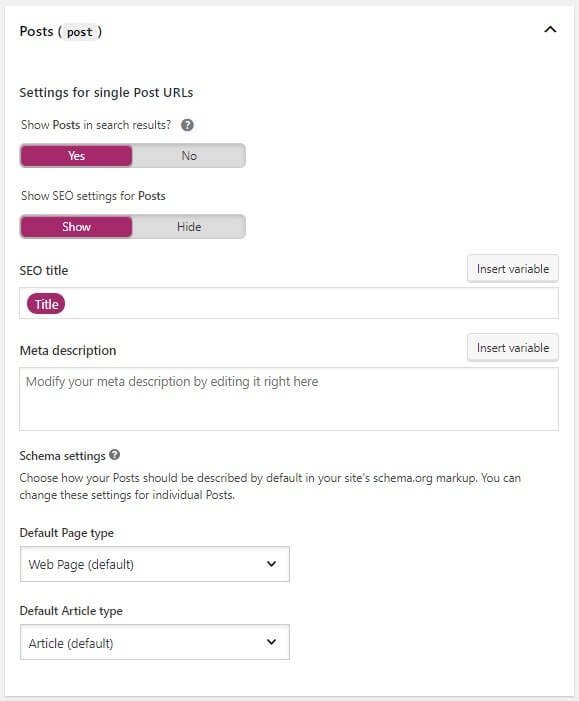
Of course, you will want to show your posts in search results of search engines, especially Google. So, turn it on.
The next option is to allow Yoast to show the SEO settings for individual posts. You can hide it, but you should not. If you hide it, you will lose the ability to add focus keyword, meta description, SEO title, etc. for your posts. You will not get the SEO checklist either. So, keep it on.
Leave the Meta description field blank, because you don’t want a generic meta description for all posts. Individual posts should have individual meta descriptions.
The next option is the Schema settings. Assuming that yours is a simple blog, the default options are perfect. You can select other options depending on what exactly your website is all about. For instance, if you are giving real estate listings, you should select the schema accordingly.
Choose wisely. Doing this wrong will F-up your website like anything! So, do not be stupid. If you don’t know what Schema does and why it is important, you better do some reading. I cannot tell everything here. Schema is a broad topic; attempting to explain it here will be ridiculous.
The next one you see is the page settings. This is what you will see:
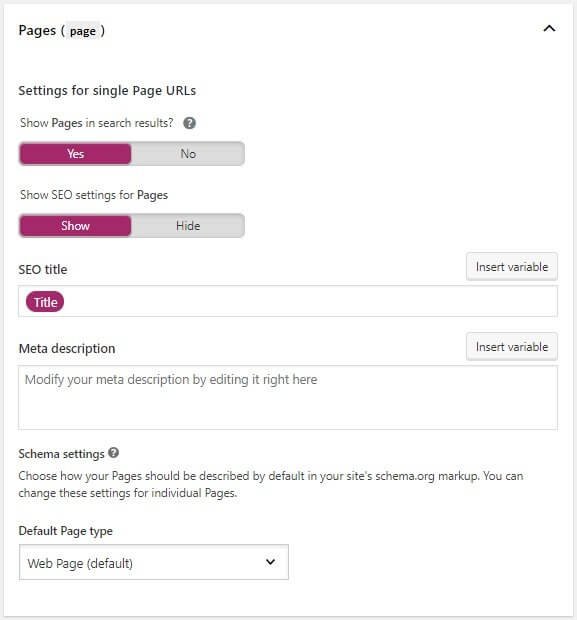
Leave everything as is. You can, however, change the schema. I will not recommend doing that here. You can set schema for individual pages. Don’t fill in the meta description, either. You will want the meta description to be different for different pages.
The Media Tab
In the media tab, leave the default setting. Don’t change it. The default setting is to redirect attachment URLs to attachments. Here is what it looks like:
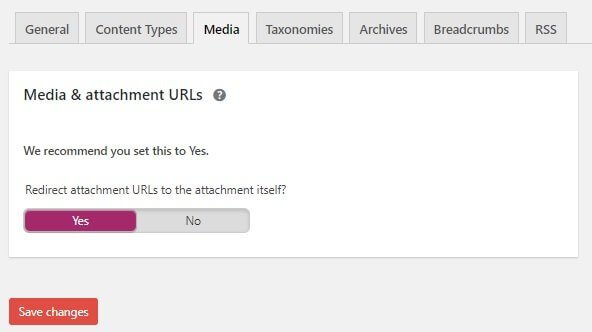
What does that mean?
It is normal to upload images to your website or blog. When you upload an image on a WordPress site, WordPress will, by default, create a separate URL for it. Yes, you can actually access the image using that URL.
The problem here is that the page where the URL will take you will only have the image. There will be no text unless you write a massive piece of content describing the image.
When the URL has only the image, Google will see it as a page with thin content. Google doesn’t like thin content. It will penalize your website for that.
So, you should redirect the image or media URL to the media attachment. That means the only way you or anyone can see the image is on the blog page, and not on an individual image URL.
This tells Google to ignore the URL for the media because the URL will redirect Google to the blog page where it can find the content (text). This will avoid the problem of thin content.
The Taxonomies Tab
In this tab, you will find four broad options – Categories, Tags, Post Formats, Category URLs. What are these? Let’s find out!
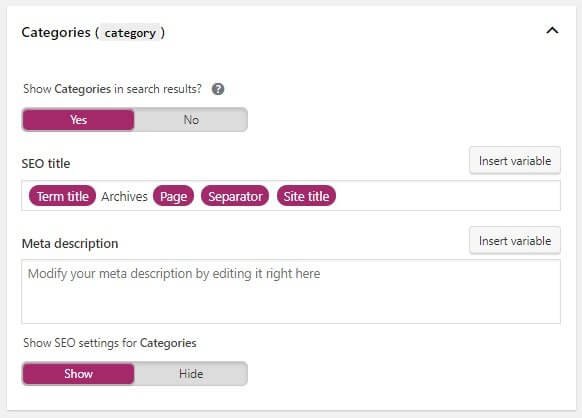
If you don’t want Google or other search engines to index the categories on your blog or website, you can set the option to ‘No.’ The default is ‘Yes.’ Usually, it is a good practice to prevent search engines from indexing the categories. Why?
That’s because they can create partial duplicates of existing web pages (basically blog posts). Such duplicates can lead to low-quality web pages that can eventually hurt your ranking. I am not saying this. It comes directly from the Google Search Console community (previously known as Webmasters forum).
I will suggest you read this thread here. If you don’t want to read the entire thread, here is a segment of it:

The same goes for tags and post format segments. Simply “noindex” them. Here is what you need to do:
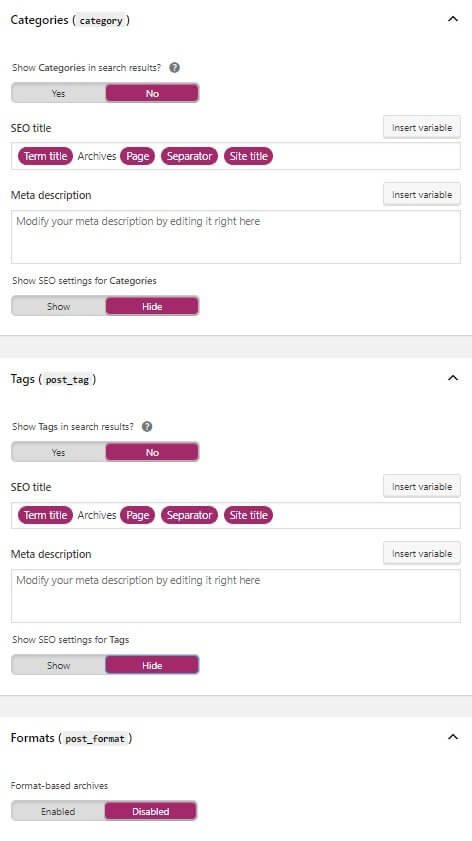
The last option is that of Category URLs. Should you keep or remove the category prefix? I will suggest you remove it. The reason is simple. Compare these two URLs:
- https://yourrandomwebsite/entertainment/how-emma-watson-destroyed-fake-feminism
- https:// yourrandomwebsite/how-emma-watson-destroyed-fake-feminism
Which one is easy for you to remember? Of course, the second one. That’s true for all readers across the web. The shorter the URL, the easier it is to remember. Keeping the category prefix (in the example above, the category prefix was ‘entertainment’) does no good, and neither does it do any harm. Just remove it.
The setting that you need to use is this:

The Archives Tab
Disable indexing for all of them. You cannot remove those archives. They will be there on your website, and people can still use them (depending on the theme that you are using), but search engines will not index them.
The reason is the same as mentioned in the Google Search Console forum.
You should not allow Google or any other search engine to index archive pages because they lead to duplicate content issues. Here is the ideal setting:
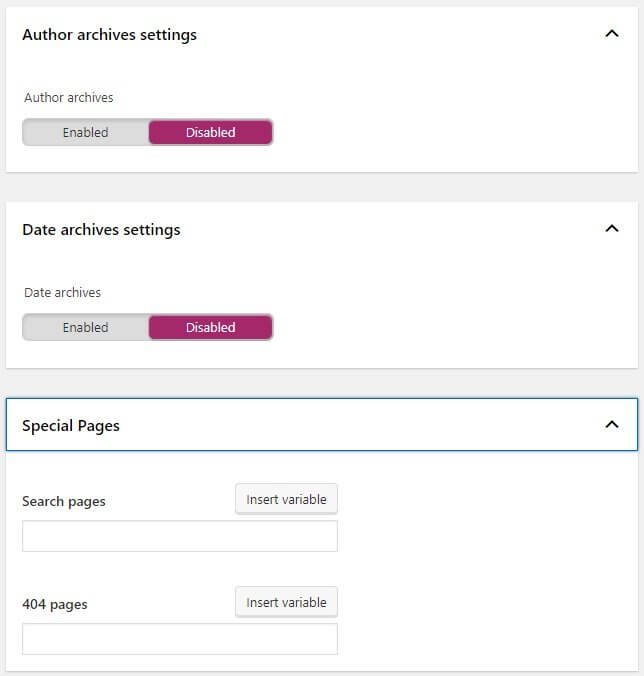
Do not do anything with the special pages. You don’t need to have SEO titles for search pages or 404 error pages. Google will see them as search pages and error pages. They don’t play a vital role in your search rankings. So, leave them without doing anything.
The Breadcrumbs Tab
If your website is too large with deep navigation, you should enable breadcrumbs. That is a good option for telling your visitors where they are on your website. It is an extra navigation layer.
From an SEO standpoint, breadcrumbs help search engines to properly index your site. It helps to improve the site rankings. Breadcrumbs reduce the bounce rate by keeping people longer on site. User engagement increases!
Here is a detailed study by the Search Engine Journal that you should read.
The default settings of Yoast is perfectly fine. Just enable it and leave it as is.
Here is what it will look like:
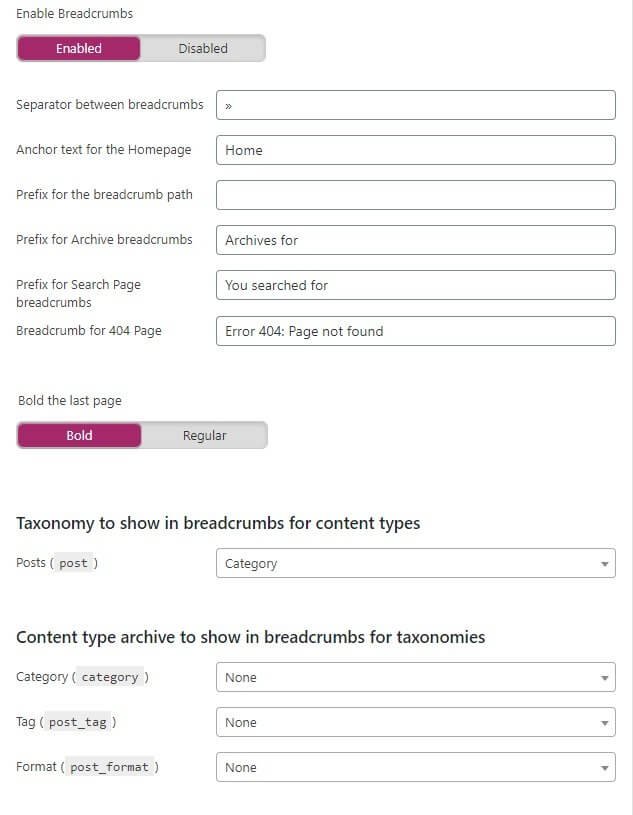
The RSS Tab
The last tab in the Search Appearance segment is the RSS tab. As I said earlier in the pros and cons segment, Yoast can prevent scrapers from raking using your content by adding a link to your blog post in the RSS feed.
The RSS tab’s default setting does so. You don’t need to change anything here. Just leave it the way it is.
Social Settings Segment
The next segment is the Social settings. To get to this segment, hover your mouse on the SEO menu item on the left of your WordPress dashboard and clicking on the Social option.
This is what I mean:
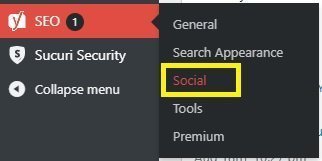
Clicking on Social will take you to the Social settings page. There is no rocket science here. There are four tabs to deal with. Let me walk you through these tabs one at a time.
The Accounts Tab
This is where you add links to your different social media profiles. There is nothing more to do here. Here is what it looks like:

I added links to Facebook, Twitter, Pinterest, and YouTube because they are the most relevant ones for me. If something else is relevant to you, add it!
The Facebook Tab
This is where you need to add Open Graph data. This is important. You have to use the right images! First, take a look at this segment:
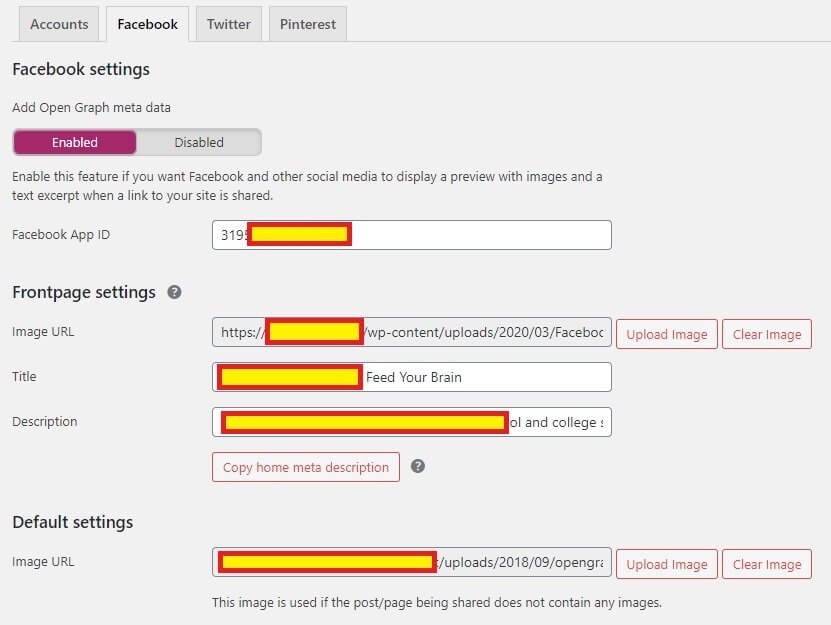
You should enable Open Graph metadata. What is Open Graph?
It is a protocol that allows developers to decide what content should be shown to people when someone shares your website either on Facebook or other social media platforms. If you don’t set the Image URL under Frontpage settings, chances are there that once your website is shared on social media, chances are high that any random image will be shown.
You don’t want that!
Again, you will see the Image URL under Default settings. This is different from the previous image URL. This one is the default image that Facebook will show if you share a post on Facebook, and that post doesn’t have any image.
So, these two images serve different purposes. Create two different images. Make sure that you are following the image measurements that Facebook prefers.
What is Facebook App ID?
When you create a Facebook page or profile, you can create an app for your website. It is not the same as your average mobile app. This app can request ads from Audience Network. To request those ads, an ID is required. You need to enter that ID here in Yoast.
In general, you can use your Facebook App to enable social login on your website. You will also need this Facebook App if you want to run contests on Facebook or get more page likes.
This is quite technical, but luckily, you don’t have to worry about these things. Usually, developers are the ones who worry about this. All you need to do is get the app ID.
If you have a Facebook profile or if you have a Facebook page, you will already have an App ID. Just Google ‘How to find Facebook App ID,’ and you will find the step-by-step guide.
Get the ID and put it in Yoast.
The Twitter Tab
If you intend to share your posts on Twitter, enable Twitter card metadata, and choose the card type. This is the settings that you need to use:
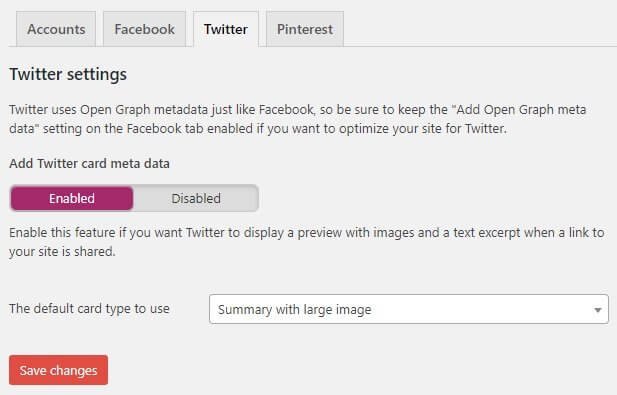
The Pinterest Tab
In this tab, you have to enter a meta tag to confirm your site with Pinterest. There is a link in Yoast settings that will allow you to get the tag.
This is how it looks like:
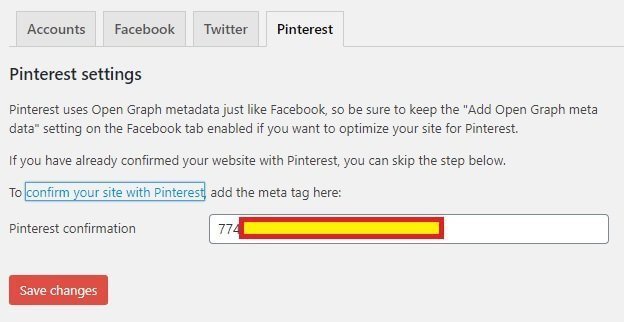
Tools Segment
To get to this segment, hover your mouse on the SEO menu item on the left of your WordPress dashboard and clicking on the Tools option.
This is what I mean:
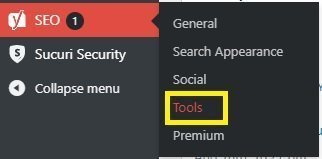
This is the segment where you can make Yoast count the total number of internal links (Text Link Counter). You can also edit the SEO title of all your posts from this segment without going into the editor for each blog post (Bulk Editor).
In case you want to edit the robots.txt or .htaccess files of your website, you can use the File Editor tool. You need to understand that you can edit .htaccess file if you have an Apache server or OpenLiteSpeed Server. If you are running the Nginx server, you will not have .htaccess file. You can, however, create or edit a robots.txt file.
Finally, you will also get import or export settings. If you are using another SEO plugin, the import option will allow you to import SEO settings from other SEO plugins. You may also export the Yoast setting and use the same on another blog.
This is what the Tools segment looks like:
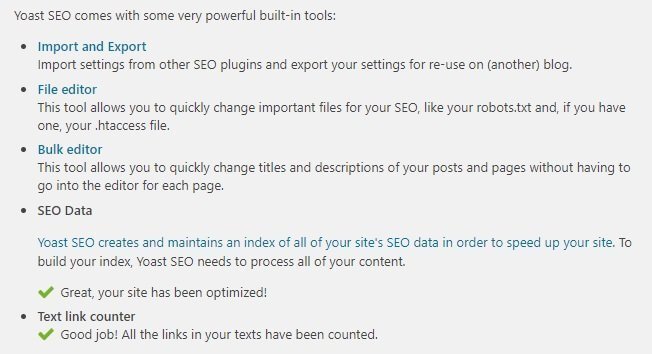
There isn’t much to discuss here. Everything is self-explanatory. All you have to do is to click and explore.
Yoast in Action
Now that you are aware of the setup process, which is quite easy (to say the least), it is about time that you take a look at how Yoast works in the background.
Do understand that I use the new Gutenberg editor. So, the Yoast interface has changed a bit. Instead of providing the SEO settings segment underneath a post (as it was earlier), Yoast now offers it both underneath a post and on the right side.
Here is what a typical post editor page looks like:
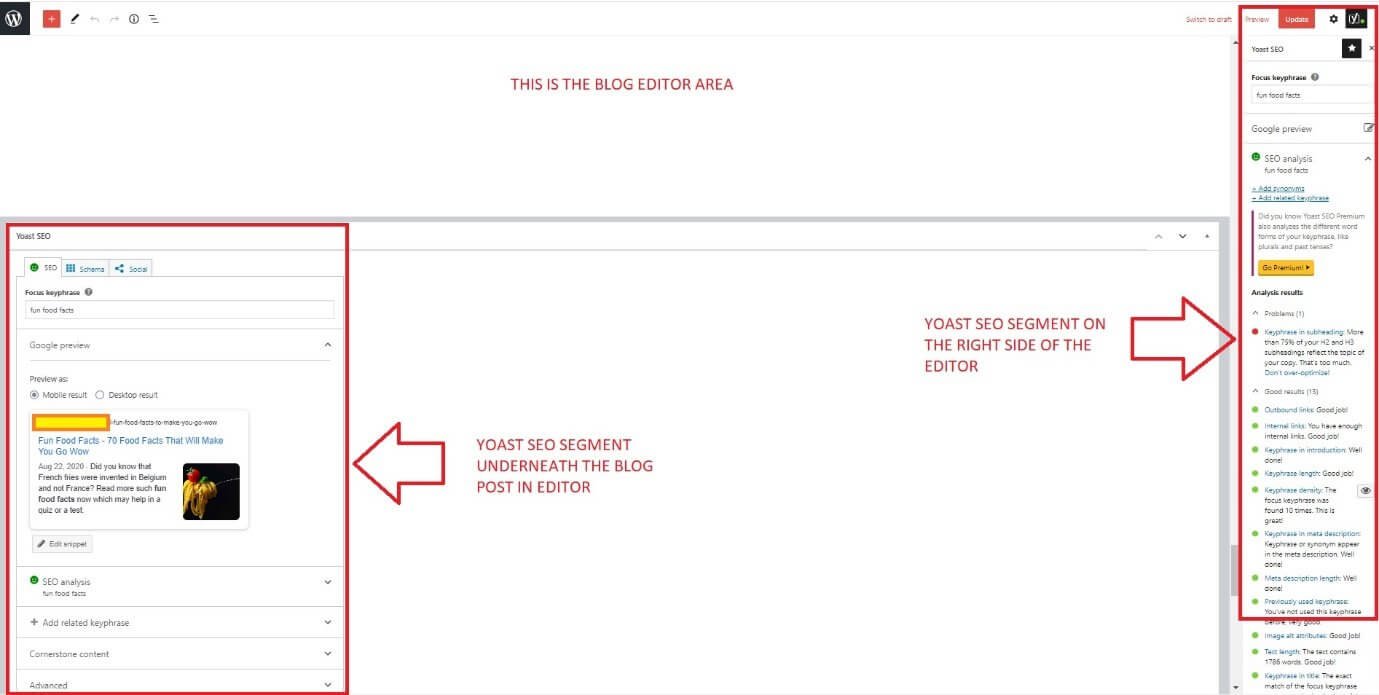
I prefer the option on the right side instead of the option below the editor. It allows easier navigation when I need to edit the post to get as many green lights as possible on Yoast. The segment on the right is more like a fixed sidebar. The rest of the screen can scroll.
So, when I make any changes to the content, I can see what changes are happing on the SEO checklist on the right-hand side. I don’t need to scroll up and down to see what happens to SEO when I make content adjustments. This is what you will need to do if you are using the Yoast segment below the content editor.
The Yoast options on the side and the options underneath the editor are identical except that the option underneath the editor will give you the option of adding social data. The one on the right side will not allow doing so.
Let me give you a closer look at both.
This is how it looks underneath the editor:

Notice carefully. You can add a focus keyword here. You have a preview of how the post will look like on mobile and how it will look like on the desktop.
You can click on the Edit Snippet button to add the meta title and meta description. Clicking on the Edit Snippet button will bring up this:
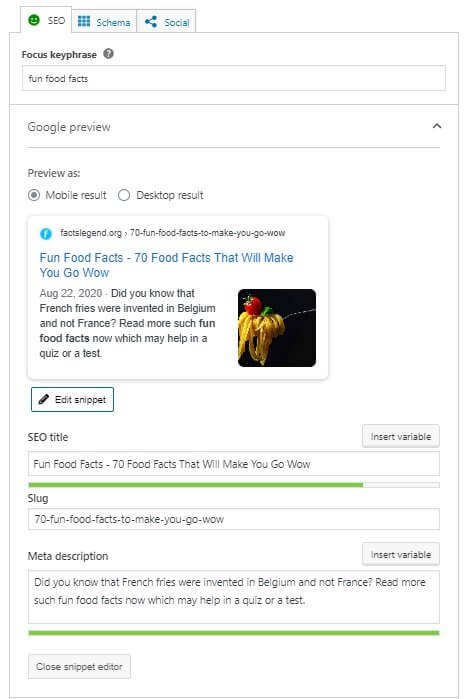
Underneath the snippet editor, you can see the SEO checklist. It looks like this:
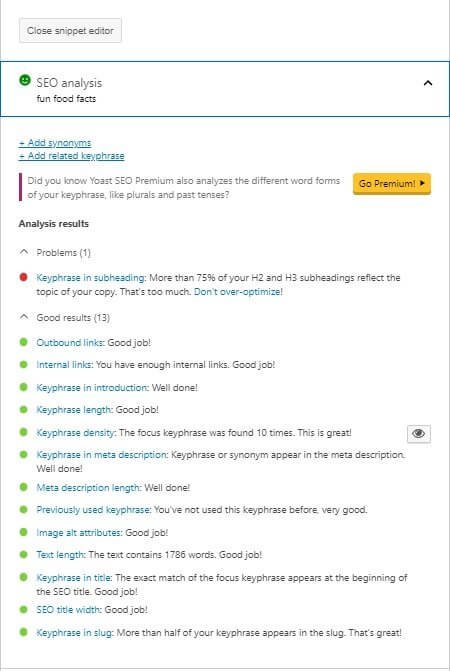
Notice how I have a red dot. It asks me to optimize the heading. I didn’t bother about it because the context and the intent of the article require that I keep the keyword in the headings. This is the failure of the Yoast SEO I spoke of earlier.
So, I don’t need to try to achieve all green dots!
Under SEO Analysis, you can see the option of adding more keywords (which you cannot unless you have the premium version of Yoast) or mark the content as a cornerstone article. This is what it looks like:

Underneath the Cornerstone option, I have the Advanced segment. Do you remember I asked you to keep the security settings on to prevent other authors from removing the post from search or change the canonical URL, etc.?
If you turn off the security option, you will see this Advanced segment. Here is what it looks like:
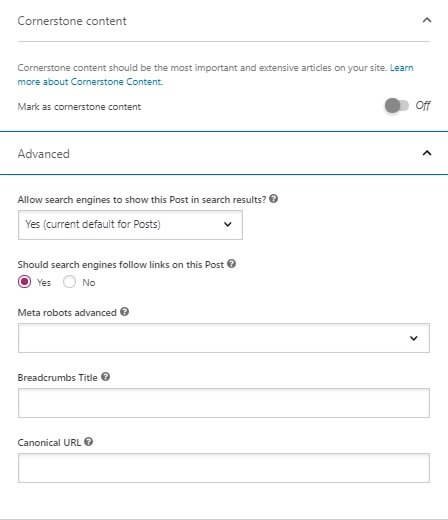
It is better not to touch anything here. The default options are what you need. Even better, turn on the security and remove the Advanced segment completely.
Now, switch over to the Schema tab, and you will see this:
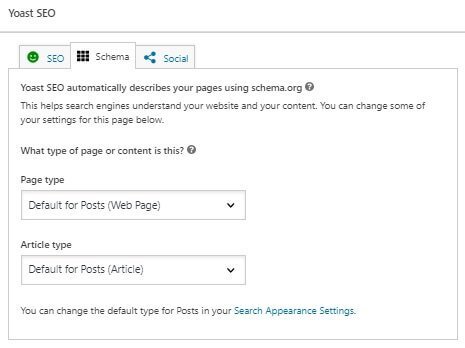
It takes the default options that I had set earlier in the Search Appearance segment. You can change this for individual articles.
Switching over to the Social tab, you will see this:
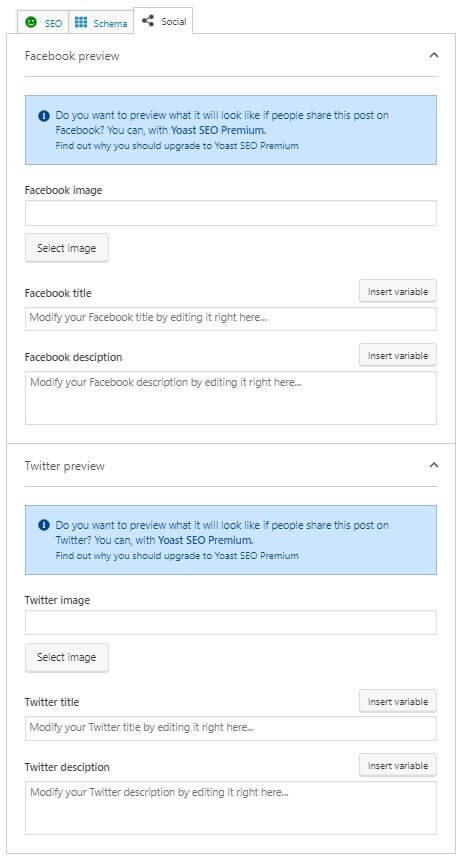
You can add a description and title separately for Facebook and Twitter. Since it is the free version of Yoast, I cannot see the preview. That’s fine! I don’t need to. I anyway don’t use this segment. I always create posts on Facebook and Twitter by going to my respective profiles on those platforms.
You get the same things on the right side of the screen except for the social options and the Advanced segment. This is what it looks like on the right:
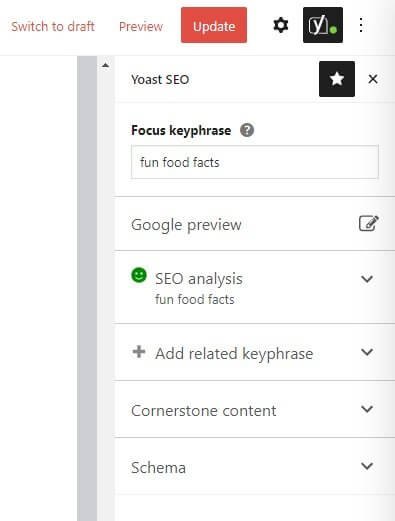
Trust me, nothing else differs. Simply expand each accordion option, and you will see the same thing as you see underneath the editor. I prefer working with this right panel. You may prefer to work with the options below the editor. It is a matter of choice.
Yoast Free Vs. Yoast Premium
I will avoid long narration and give you a table. It should suffice.
| Free | Premium |
| Only Focus Keyword | Only one focus keyword plus the ability to add related keywords |
| Content analysis – Readability check | Content analysis – Readability check |
| XML sitemaps | XML sitemaps |
| Breadcrumbs | Breadcrumbs |
| Schema data | Schema data |
| SEO analysis | SEO analysis |
| Bulk editor | Bulk editor |
| SEO settings import and export | SEO setting import and export |
| Internal link counter | Internal link counter |
| Social media optimization but no preview | Social media optimization with preview |
| Cornerstone article | Cornerstone article |
| Price: Free | Internal link suggestion |
| Redirect manager to efficiently create redirects. This feature will identify dead links and ask you to redirect to some page on your blog (usually the homepage). You can create different types of redirects as well. They are 404, 301, 302, 307, 410, and 451 redirects. | |
| 24/7 email support by Yoast team. | |
| Orphaned content – if you have a blog post that doesn’t have any internal links, Yoast will create a list of them under the header ‘Orphaned’ content. You can then easily create internal links for them. | |
| No ads! | |
| Price: $89 per year for a single site. |
Conclusion
Yoast is a good SEO plugin. It can take care of the technical aspects of on-page SEO effortlessly. Using it is easy. However, never consider Yoast as the master. It is only a guide. The free version is powerful enough to give your site a nice SEO boost.
The premium version comes with some extra features that can improve your site’s overall SEO. Unfortunately, the asking price for the premium version is too high for the insufficient number of extra features it offers.
As far as the support is concerned, you don’t really need any support for using the Yoast plugin. So, the 24/7 email support that Yoast premium talks about is pretty useless.
Should you use Yoast?
Of course, you should! There is no denying that you will need one SEO plugin. Yoast is just fine. However, if you need more options for free, you should look for RankMath as an alternative. It is absolutely free and has way more features compared to Yoast Premium.
Do remember that RankMath still has some issues with BuddyPress, but if you are not using BuddyPress, RankMath is a viable option. But RankMath can be very overwhelming because of too many options. If you are new to WordPress and WordPress SEO, I will suggest you stick with Yoast. It is simple and effective.
